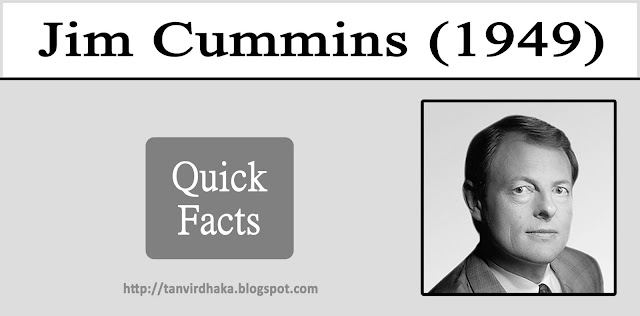Jim Cummins is a renowned SLA educator and one of the world’s most important theorists on bilingual education and second language acquisition. Cummins is also a prolific writer who authored and co-authored a number of notable books that reflect his theoretical perspective.
Full Name: James Patrick Cummins
AKA: J. Cummins, James Cummins
Date of Birth: July 3, 1949
Birthplace: Dublin, Ireland
Zodiac Sign: Cancer
Nationality: Irish/Canadian
Ethnicity: Irish
Siblings: 2 brothers
Education: University of Alberta; The National University of Ireland
Cummins is known for: his concept of Basic Interpersonal Communication Skills (BICS), Cognitive Academic Language Proficiency (CALP), and Common Underlying Proficiency (CUP).
Cummins was influenced by: Tove Skutnabb-Kangas, Lily Wong Fillmore, Stephen Krashen, Merril Swain, Alma Flor Ada, and Denis Sayers.
2005: Heritage languages.
2003: Lenguaje, poder y pedagogia. Ninos y ninas bilingues entre dos fuegos.
2001: Negotiating identities: Education for empowerment in a diverse society.
2000: Language, power, and pedagogy: Bilingual children in the crossfire.
1999: Taftotites ypo Diapragmatefsi.
1996: Negotiating identities: Education for empowerment in a diverse society.
1995/1997: Brave new schools: Challenging cultural illiteracy through global learning networks.
1991: Language learning and bilingualism.
1990: Heritage languages: The development and denial of Canada's linguistic resources.
1989: Assessment and placement of minority students.
1989: Empowering minority students.
1986: Bilingualism in education: Aspects of theory, research and policy.
1984: Bilingualism and special education: Issues in assessment and pedagogy.
1983: Heritage language education: A literature review.
1981: Effects of French language experience at Kindergarten level on academic progress in French immersion programs.
1981: Bilingualism and minority language children.
Profile
Name: Jim CumminsFull Name: James Patrick Cummins
AKA: J. Cummins, James Cummins
Date of Birth: July 3, 1949
Birthplace: Dublin, Ireland
Zodiac Sign: Cancer
Nationality: Irish/Canadian
Ethnicity: Irish
Siblings: 2 brothers
Education: University of Alberta; The National University of Ireland
Cummins is known for: his concept of Basic Interpersonal Communication Skills (BICS), Cognitive Academic Language Proficiency (CALP), and Common Underlying Proficiency (CUP).
Cummins was influenced by: Tove Skutnabb-Kangas, Lily Wong Fillmore, Stephen Krashen, Merril Swain, Alma Flor Ada, and Denis Sayers.
Quotes
“When students' language, culture and experience are ignored or excluded in classroom interactions, students are immediately starting from a disadvantage. Everything they have learned about life and the world up to this point is being dismissed as irrelevant to school learning; there are few points of connection to curriculum materials or instruction and so students are expected to learn in an experiential vacuum. Students' silence and nonparticipation under these conditions have frequently been interpreted as lack of academic ability or effort, and teachers’ interactions with students have reflected a pattern of low expectations which become self-fulfilling.”
-Jim Cummins, Negotiating Identities: Education for Empowerment in a Diverse Society
Major Works
2007: Literacy, technology, and diversity: Teaching for success in changing times.2005: Heritage languages.
2003: Lenguaje, poder y pedagogia. Ninos y ninas bilingues entre dos fuegos.
2001: Negotiating identities: Education for empowerment in a diverse society.
2000: Language, power, and pedagogy: Bilingual children in the crossfire.
1999: Taftotites ypo Diapragmatefsi.
1996: Negotiating identities: Education for empowerment in a diverse society.
1995/1997: Brave new schools: Challenging cultural illiteracy through global learning networks.
1991: Language learning and bilingualism.
1990: Heritage languages: The development and denial of Canada's linguistic resources.
1989: Assessment and placement of minority students.
1989: Empowering minority students.
1986: Bilingualism in education: Aspects of theory, research and policy.
1984: Bilingualism and special education: Issues in assessment and pedagogy.
1983: Heritage language education: A literature review.
1981: Effects of French language experience at Kindergarten level on academic progress in French immersion programs.
1981: Bilingualism and minority language children.
Major Theories
- Zone of Proximal Development (1994)
- BICS (Basic Interpersonal Communicative Skills) (1981)
- CALPS (Cognitive Academic Linguistics Proficiency Skills) (1981)
- CUP (The Common Underlying Proficiency Model) (1981)
- SUP (The Separate Underlying Proficiency Model) (1981)
- Iceberg Theory (1981)
- Due Icebergs Theory (1981)
- Threshold Hypothesis (1981)
- Length of Time Hypothesis (1981)
- Blaming the Victim (1989)
Did you know?
- Jim Cummins was born in Dublin to a middle class family with a respectable banking officer father.
- Jim Cummins emigrated to Canada due to turbulent socio-political condition in the then colonized Ireland.
- Jim Cummins earned his B.A. (honours) in Psychology with first class from the National University of Ireland In 1970.
- Cummins attained his diploma in Applied Psychology from The National University of Ireland in 1971.
- He earned his doctorate degree in Educational Psychology in 1974 from the University of Alberta.
- During 1976 to 1978 period, he became involved with the Canadian “Parents for French” movement.
- Cummins was awarded an honorary doctorate from the Bank Street College of Education in New York City In 1997.
- He is currently a professor at the Ontario Institute for Studies in Education of the University of Toronto.
- His research centers on the nature of language proficiency and second language acquisition.
- The corpus of his publications is voluminous which includes books, journals, monographs, tests and curriculum programs, book chapters, book forwards, and book reviews.












